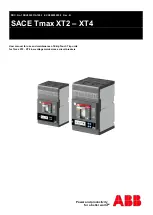
45
Instruction manual
| Types SDV-R and SDV-R-AR distribution circuit breakers
High-potential tests
The next series of tests (vacuum-integrity test
and insulation tests) involve use of high-
voltage test equipment. The SDV-R operator
under test should be inside a suitable test
barrier equipped with warning lights.
Vacuum-integrity check
A high-potential test is used to verify the
vacuum integrity of the vacuum interrupters.
The test is conducted on the circuit breaker
vacuum interrupter primary contacts in the
open position (ground switch vacuum
interrupter contacts closed) and with ground
switch vacuum interrupter primary contacts
in the OPEN position (circuit breaker vacuum
interrupter contacts closed).
Vacuum integrity test procedure
1. Observe safety precautions listed in the
danger and caution advisories. Construct
the proper barrier and warning light
system.
2. Ground the frame of the circuit breaker
and ground each pole not under test.
3. Apply test voltage (60 kV ac rms or 85 dc)
across each circuit breaker vacuum
interrupter for one minute (circuit breaker
open) or across each ground switch
vacuum interrupter for one minute (circuit
breaker closed).
4. If the vacuum interrupter sustains the test
voltage for that period, the vacuum
integrity has been verified.
Note:
The dc test voltage is given as a
reference only. It represents values believed
to be appropriate and approximately
equivalent to the required power-frequency
withstand test value from ANSI/IEEE C37.04.
The presence of this information in no way
implies any requirement for a dc withstand
test on ac equipment or that a dc withstand
test represents an acceptable alternative to ac
withstand tests. When making dc tests, the
voltage should be raised to the test value in
discrete steps and held for a period of one
minute.
Do not use dc high-potential testers
incorporating half-wave rectification. Such
devices produce high-peak voltages.
These high voltages will produce X-ray
radiation. Such devices also show erroneous
readings of leakage current when testing
vacuum circuit breakers.
Note:
This test includes not only the vacuum
interrupter, but also the other insulation
components in parallel with the vacuum
interrupter. These include the post insulators
and the insulating coupler, as well as the
insulating (tension) struts between the upper
and lower vacuum interrupter supports. If
these insulation components are
contaminated or defective, the test voltage
will not be sustained. If so, clean or replace
the affected components, and retest.
If dc high-potential tests are used, note the
following:
•
If a dc test indicates loss of vacuum,
reverse the polarity of the test leads and
retest.
•
If the second test is successful, the
vacuum interrupter has adequate
vacuum integrity.
•
If the second test also indicates loss of
vacuum integrity, replace the vacuum
interrupter.
As-found insulation and contact-
resistance tests
As-found tests verify the integrity of the
circuit breaker insulation system. Megger* or
insulation-resistance tests and contact-
resistant tests conducted on equipment prior
to installation provide a basis of future
comparison to detect changes in the
protection afforded by the insulation system,
and in the integrity of the current-carrying
path. A permanent record of periodic as-
found tests enables the maintenance
organization to determine when corrective
actions are required by watching for
significant deterioration in insulation
resistance, or increase in contact resistance.
Insulation and contact-resistance test
equipment
In addition to the high-potential test
equipment capable of test voltages, the
following equipment is also required:
•
AC high-potential tester with test voltage
of 1,500 volts, 60 Hz.
•
Test equipment for contact-resistance
tests.
* Megger is a registered trademark
of Megger Group, Ltd.











































